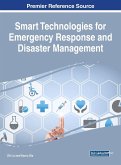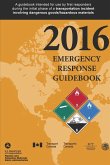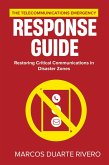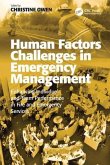Handbook of Emergency Response
A Human Factors and Systems Engineering Approach, Second Edition
Herausgeber: Racz, Leeann; Badiru, Adedeji B.
Handbook of Emergency Response
A Human Factors and Systems Engineering Approach, Second Edition
Herausgeber: Racz, Leeann; Badiru, Adedeji B.
- Gebundenes Buch
- Merkliste
- Auf die Merkliste
- Bewerten Bewerten
- Teilen
- Produkt teilen
- Produkterinnerung
- Produkterinnerung
This second edition of Handbook of Emergency Response presents practical advice and guidelines on how to plan the coordinated execution of emergency response. It incorporates human factors and a systems engineering approach in emergency response project management.
Andere Kunden interessierten sich auch für
![Emergency Management and Disaster Response Utilizing Public-Private Partnerships Emergency Management and Disaster Response Utilizing Public-Private Partnerships]() Emergency Management and Disaster Response Utilizing Public-Private Partnerships184,99 €
Emergency Management and Disaster Response Utilizing Public-Private Partnerships184,99 €![Smart Technologies for Emergency Response and Disaster Management Smart Technologies for Emergency Response and Disaster Management]() Smart Technologies for Emergency Response and Disaster Management206,99 €
Smart Technologies for Emergency Response and Disaster Management206,99 €![Emergency Response Guidebook 2016 Emergency Response Guidebook 2016]() U. S. Department of Health and Human ServEmergency Response Guidebook 201630,99 €
U. S. Department of Health and Human ServEmergency Response Guidebook 201630,99 €![The Telecommunications Emergency Response Guide The Telecommunications Emergency Response Guide]() Marcos Duarte RiveroThe Telecommunications Emergency Response Guide20,99 €
Marcos Duarte RiveroThe Telecommunications Emergency Response Guide20,99 €![AI and Emerging Technologies for Emergency Response and Smart Cities AI and Emerging Technologies for Emergency Response and Smart Cities]() AI and Emerging Technologies for Emergency Response and Smart Cities269,99 €
AI and Emerging Technologies for Emergency Response and Smart Cities269,99 €![Human Factors Challenges in Emergency Management Human Factors Challenges in Emergency Management]() Human Factors Challenges in Emergency Management190,99 €
Human Factors Challenges in Emergency Management190,99 €![Human Factors Challenges in Emergency Management Human Factors Challenges in Emergency Management]() Human Factors Challenges in Emergency Management75,99 €
Human Factors Challenges in Emergency Management75,99 €-
-
-
This second edition of Handbook of Emergency Response presents practical advice and guidelines on how to plan the coordinated execution of emergency response. It incorporates human factors and a systems engineering approach in emergency response project management.
Produktdetails
- Produktdetails
- Verlag: CRC Press
- 2. Auflage
- Seitenzahl: 526
- Erscheinungstermin: 12. September 2025
- Englisch
- Abmessung: 240mm x 161mm x 33mm
- Gewicht: 948g
- ISBN-13: 9781041073482
- ISBN-10: 1041073488
- Artikelnr.: 73611329
- Herstellerkennzeichnung
- Libri GmbH
- Europaallee 1
- 36244 Bad Hersfeld
- gpsr@libri.de
- Verlag: CRC Press
- 2. Auflage
- Seitenzahl: 526
- Erscheinungstermin: 12. September 2025
- Englisch
- Abmessung: 240mm x 161mm x 33mm
- Gewicht: 948g
- ISBN-13: 9781041073482
- ISBN-10: 1041073488
- Artikelnr.: 73611329
- Herstellerkennzeichnung
- Libri GmbH
- Europaallee 1
- 36244 Bad Hersfeld
- gpsr@libri.de
LeeAnn Racz is a Supervising Engineer at ToxStrategies LLC in Fort Walton Beach, FL. Prior to this initiative, she was President and Founder of ClearView Environmental Engineering and Consulting, and she served for 23 years as a bioenvironmental engineer and civil engineer in the US Air Force. Dr Racz is a licensed professional engineer, certified industrial hygienist, and board-certified environmental engineer. She earned a BS in Environmental Engineering from California Polytechnic State University, San Luis Obispo, an MS in Biological and Agricultural Engineering from the University of Idaho, and a PhD in Civil and Environmental Engineering from the University of Utah. She has authored dozens of refereed journal articles, conference proceedings, magazine articles, and presentations, and edited six handbooks. Dr Racz is a member of several professional organizations and honor societies and has received numerous prestigious teaching and research awards. Adedeji B. Badiru is Dean Emeritus and a retired Professor of Systems Engineering at the Air Force Institute of Technology (AFIT). He is a registered professional engineer and a fellow of the Institute of Industrial Engineers, as well as a fellow of the Nigerian Academy of Engineering. He has a BS degree in Industrial Engineering, an MS in Mathematics and an MS in Industrial Engineering from Tennessee University, and a PhD in Industrial Engineering from the University of Central Florida. He is the author of several books and technical journal articles and has received several awards and recognitions for his accomplishments. His special skills, experience, and interests center on research mentoring of faculty and graduate students.
1. Resilient Organizations Overcome Challenges to Unified Response. 2. A
Multi-layered Dynamic Systems Model of Disaster Response. 3. Creating
Effective Response Communications. 4. Effectively Communicating Risk and
Uncertainty to the Public in Crises. 5. Time Is a Murderer: The Cost of
Critical Path Drag in Emergency Response. 6. Evacuation Planning, Analysis,
and Management. 7. Planning and Management of Transportation Systems for
Evacuation. 8. Modeling and Simulation of Fuel Availability at Gas Stations
During Extreme Events. 9. Deciphering the Code of False Alarms to
Understand Public Response to Emergency Warnings. 10. Damage Assessment and
the Use of Technology after Disasters: Implications for Emergency Managers
and Others Involved in an Important Function. 11. Revisiting Human Behavior
after Disasters: The Possibility of Anti-Social Activity and its Relation
to Disaster Assistance. 12. Current Threats to Biosecurity. 13. An
Integrated Approach to Planning for and Responding to Ionizing Radiation
Incidents. 14. Understanding the Impacts of Heat. 15. Coordinated Project
Management for Emergency Response. 16. DEJI Systems Model: Factors and
Elements for Emergency Response. 17. Cooperation and Compliance in
Emergency Response. 18. Emergency Response: Systems-based Use of Finland's
Concept of Sisu. 19. Emergency Response Process Improvement Using Lean Six
Sigma Techniques. 20. Learning Curve Application for Emergency Response.
21. Systems Engineering Framework for Environmental Conservation and
Restoration Management. 22. Climate-Change Drivers for Emergency Response.
23. Qualitative Impact of Climate Change, Infrastructure Integrity,
Sustainability, and Environmental Degradation on Emergency Response
Programs.
Multi-layered Dynamic Systems Model of Disaster Response. 3. Creating
Effective Response Communications. 4. Effectively Communicating Risk and
Uncertainty to the Public in Crises. 5. Time Is a Murderer: The Cost of
Critical Path Drag in Emergency Response. 6. Evacuation Planning, Analysis,
and Management. 7. Planning and Management of Transportation Systems for
Evacuation. 8. Modeling and Simulation of Fuel Availability at Gas Stations
During Extreme Events. 9. Deciphering the Code of False Alarms to
Understand Public Response to Emergency Warnings. 10. Damage Assessment and
the Use of Technology after Disasters: Implications for Emergency Managers
and Others Involved in an Important Function. 11. Revisiting Human Behavior
after Disasters: The Possibility of Anti-Social Activity and its Relation
to Disaster Assistance. 12. Current Threats to Biosecurity. 13. An
Integrated Approach to Planning for and Responding to Ionizing Radiation
Incidents. 14. Understanding the Impacts of Heat. 15. Coordinated Project
Management for Emergency Response. 16. DEJI Systems Model: Factors and
Elements for Emergency Response. 17. Cooperation and Compliance in
Emergency Response. 18. Emergency Response: Systems-based Use of Finland's
Concept of Sisu. 19. Emergency Response Process Improvement Using Lean Six
Sigma Techniques. 20. Learning Curve Application for Emergency Response.
21. Systems Engineering Framework for Environmental Conservation and
Restoration Management. 22. Climate-Change Drivers for Emergency Response.
23. Qualitative Impact of Climate Change, Infrastructure Integrity,
Sustainability, and Environmental Degradation on Emergency Response
Programs.
1. Resilient Organizations Overcome Challenges to Unified Response. 2. A
Multi-layered Dynamic Systems Model of Disaster Response. 3. Creating
Effective Response Communications. 4. Effectively Communicating Risk and
Uncertainty to the Public in Crises. 5. Time Is a Murderer: The Cost of
Critical Path Drag in Emergency Response. 6. Evacuation Planning, Analysis,
and Management. 7. Planning and Management of Transportation Systems for
Evacuation. 8. Modeling and Simulation of Fuel Availability at Gas Stations
During Extreme Events. 9. Deciphering the Code of False Alarms to
Understand Public Response to Emergency Warnings. 10. Damage Assessment and
the Use of Technology after Disasters: Implications for Emergency Managers
and Others Involved in an Important Function. 11. Revisiting Human Behavior
after Disasters: The Possibility of Anti-Social Activity and its Relation
to Disaster Assistance. 12. Current Threats to Biosecurity. 13. An
Integrated Approach to Planning for and Responding to Ionizing Radiation
Incidents. 14. Understanding the Impacts of Heat. 15. Coordinated Project
Management for Emergency Response. 16. DEJI Systems Model: Factors and
Elements for Emergency Response. 17. Cooperation and Compliance in
Emergency Response. 18. Emergency Response: Systems-based Use of Finland's
Concept of Sisu. 19. Emergency Response Process Improvement Using Lean Six
Sigma Techniques. 20. Learning Curve Application for Emergency Response.
21. Systems Engineering Framework for Environmental Conservation and
Restoration Management. 22. Climate-Change Drivers for Emergency Response.
23. Qualitative Impact of Climate Change, Infrastructure Integrity,
Sustainability, and Environmental Degradation on Emergency Response
Programs.
Multi-layered Dynamic Systems Model of Disaster Response. 3. Creating
Effective Response Communications. 4. Effectively Communicating Risk and
Uncertainty to the Public in Crises. 5. Time Is a Murderer: The Cost of
Critical Path Drag in Emergency Response. 6. Evacuation Planning, Analysis,
and Management. 7. Planning and Management of Transportation Systems for
Evacuation. 8. Modeling and Simulation of Fuel Availability at Gas Stations
During Extreme Events. 9. Deciphering the Code of False Alarms to
Understand Public Response to Emergency Warnings. 10. Damage Assessment and
the Use of Technology after Disasters: Implications for Emergency Managers
and Others Involved in an Important Function. 11. Revisiting Human Behavior
after Disasters: The Possibility of Anti-Social Activity and its Relation
to Disaster Assistance. 12. Current Threats to Biosecurity. 13. An
Integrated Approach to Planning for and Responding to Ionizing Radiation
Incidents. 14. Understanding the Impacts of Heat. 15. Coordinated Project
Management for Emergency Response. 16. DEJI Systems Model: Factors and
Elements for Emergency Response. 17. Cooperation and Compliance in
Emergency Response. 18. Emergency Response: Systems-based Use of Finland's
Concept of Sisu. 19. Emergency Response Process Improvement Using Lean Six
Sigma Techniques. 20. Learning Curve Application for Emergency Response.
21. Systems Engineering Framework for Environmental Conservation and
Restoration Management. 22. Climate-Change Drivers for Emergency Response.
23. Qualitative Impact of Climate Change, Infrastructure Integrity,
Sustainability, and Environmental Degradation on Emergency Response
Programs.








